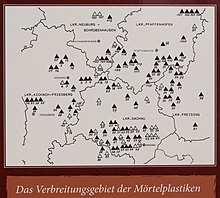Mortar plastic
A mortar sculpture is a relief- like representation of mostly religious motifs on farmhouses, stables and brick barns, in the manner of a stucco . The folk art was in the last quarter of the 19th century in the area between Munich and the Danube common.
The figures were sketched by driving pegs or nails and connecting them with wires. The creation of a mortar sculpture often begins with the application of the base mortar in a recess in the wall surface in order to create a good bond between the plastic and the substrate. The mortar consisted of lime of sand and plaster ( stucco ) was mixed into a fine mass. This was then applied in layers and the motifs were modeled from them. The work had to be completed until the mass hardened. The weather-resistant bas-reliefs were then colored in focus . They mostly depict religious motifs, but also animals and craftsmen.
Practically all of the mortar sculptures that have been preserved come from the Unterweilenbach bricklayer Bartholomäus Ostermair and are now a listed building .
Web links
Individual evidence
- ↑ Eva Strauss: Location history Upper Bavaria: Excursions into the past . 2nd revised, ext. and updated edition. Ars Vivendi, Cadolzburg 2015, ISBN 3-86913-556-5 ( arsvivendi.com [PDF]).
- ↑ Robert Böck: The mortar sculptures of Batholomäus Ostermair . In: Stadt Friedberg (Hrsg.): Stadtbuch Friedberg . tape 2 . Friedberg 1991, ISBN 3-9802818-0-9 , pp. 758 f .
- ^ Wiebke Heider: House decorations and house blessings . In: House, Farm and Home . tape 6 , 2008.

